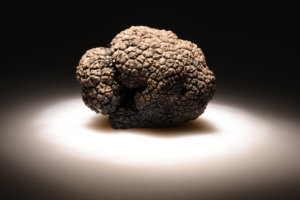Black Perigord truffles, which ripen in mid-winter, can bring $700 to $1,000 a pound. Summer Burgundy truffles bring less, $250 to $350 a pound, but make up for it with a significantly higher yield, so both varieties are equally valuable in terms of per-acre income. Growers who plant both can extend their harvest season from September through February. And with today’s scientific advances, both varieties are becoming relatively easy to grow.
In his presentation on the business side of truffle growing during the Scientific Grower Truffle Cultivation Seminar at the 2016 Truffle Festival, Robert Chang, chief truffle officer at the American Truffle Company, showed that the main requirements to reaping a healthy and steady income from truffle production are suitable land, an investment of about $30,000 per acre, careful maintenance — and the patience to wait five to seven years for a profit.
That’s how long it takes for the fungus, which is in a symbiotic relationship with its inoculated host tree, to grow large enough to produce the underground treasure.
Compared to grape cultivation, which also takes a number of years to bear financial and literal fruit, truffles offer a much longer and more reliable payout, without many of the costs associated with grapegrowing. “Truffle growing is knowledge intensive, rather than labor intensive,” Robert said. The American Truffle Company provides that knowledge as it partners with growers around the world.
Planting and growing the trees may not require a lot of labor, but the knowledge to do it properly is critical. Chang stressed that managing the environment — including amending the soil to provide truffles with the very high pH soil they prefer — is key, as is planting high-quality trees that are uncontaminated by inferior types of truffles that could crowd out the good ones. Scientific monitoring and management over time is equally important to insure success; the failure rate for orchards that are left to their own devices without scientific management is extremely high.

Truffles can be difficult to grow, but researchers are developing ever greater insight into the science behind their successful cultivation. And once they are properly established and monitored, they offer high rewards. The Perigord truffle fungus will continue to produce its valuable black nuggets for decades as long as the oak and hazelnut trees that host it continue to grow and flourish.
Those nuggets are not quite worth their weight in gold, but they are still very valuable. Robert reported that truffle prices have been climbing 4% annually, outstripping inflation — and demand continues to rise, with no end in sight.



